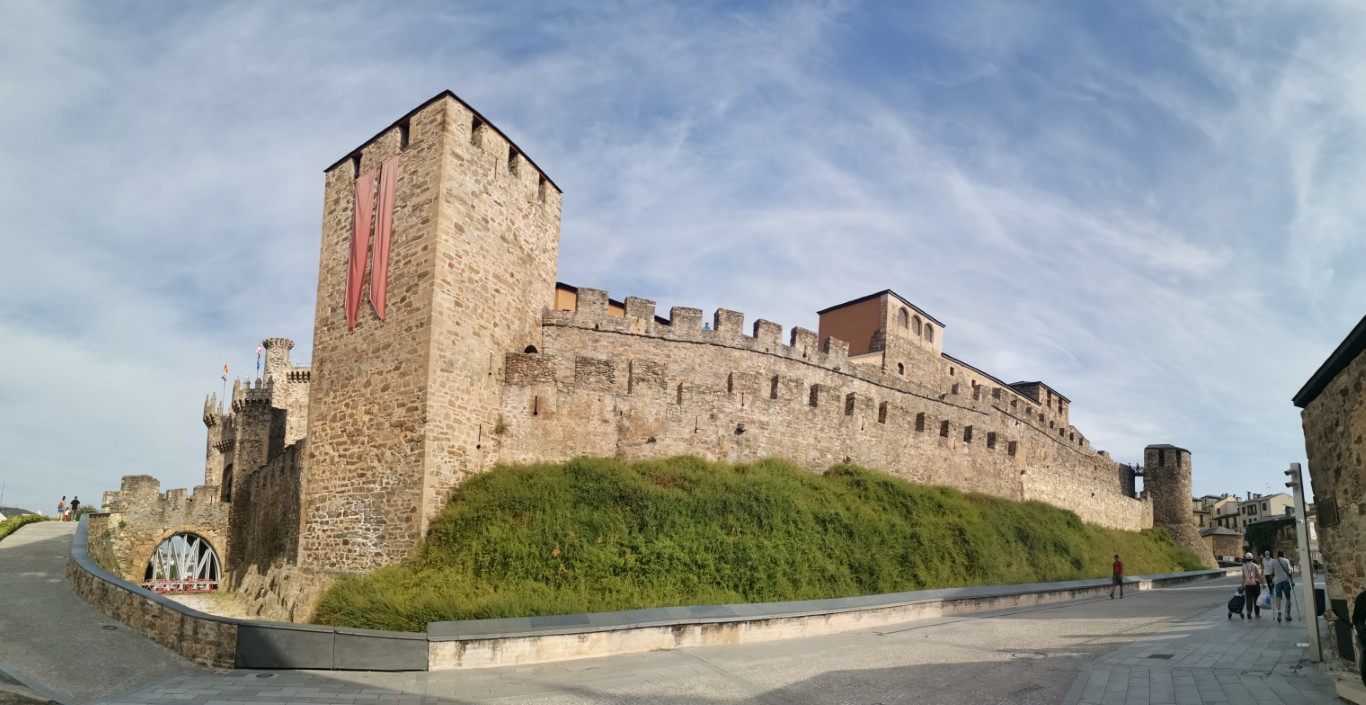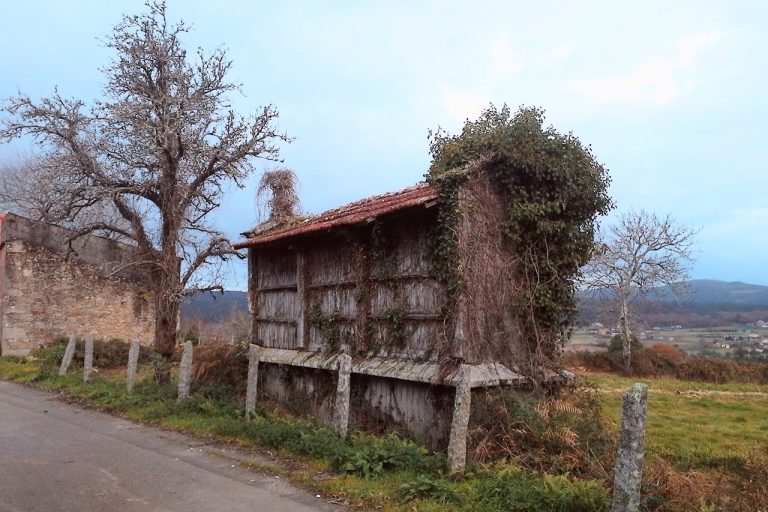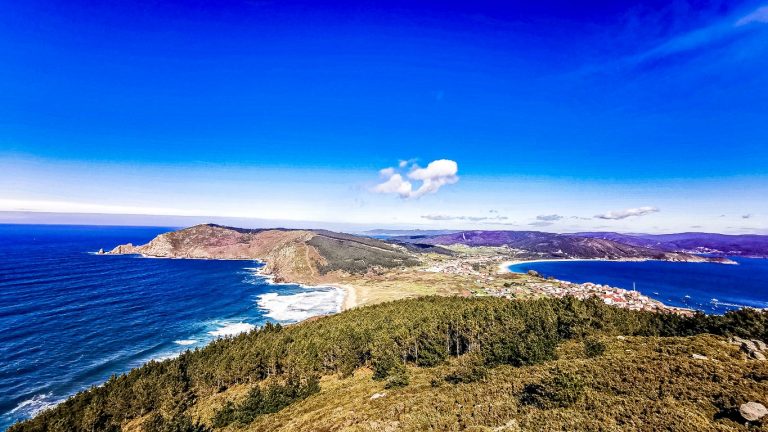
A New Stage – Entry & Atmosphere
The morning in Rabanal del Camino begins quietly, only the ringing of bells and the creaking of the old wooden doors of the albergues echo through the fresh mountain air. Ahead of you lies one of the most symbolic stages of the entire St. James Way: the ascent into the Montes de León, the legendary Cruz de Ferro, steep descents through ancient villages – and finally, arrival in Ponferrada, the Templar city at the heart of El Bierzo. With the first step out of town you sense that this day will be more than just kilometers: it is trial, symbol, and promise all at once.
The stage from Rabanal del Camino to Ponferrada (35.2 km) unites spirituality and nature, history and hospitality. Whoever walks this way immerses themselves in a centuries-old tradition of letting go, of effort, and of arriving in a new world.
Route & Elevation Profile
- Distance: 35.2 km
- Elevation: approx. +280 m / –950 m
- Difficulty: medium to high – especially due to the length and the steep, technically demanding descents.
- Character: A steady ascent up to the Cruz de Ferro, followed by a long and partly dangerous descent over rocky paths to Molinaseca, then an extended valley stretch into Ponferrada.
This stage is one of contrasts: the quiet, almost meditative ascent to the Cruz de Ferro, followed by the demanding descent into the depths of El Bierzo. The final kilometers into Ponferrada may seem easy – and yet they are a mental challenge after such a long day.














Variants & Small Detours
- Cyclists: The descent from Foncebadón through El Acebo to Riego de Ambrós is dangerous. The parallel route on the LE-142 is recommended.
- Pilgrims with limitations: Here too, the road is the safer choice – especially between Cruz de Ferro and Molinaseca.
- Stage division: Many pilgrims end the stage in Molinaseca (approx. 28 km), reducing the strain and reaching Ponferrada more relaxed the following day.
Description of the Way – With All Senses
Beyond Rabanal the path winds upward between old stone walls and oak groves. Soon the village lies behind you, and the Camino carries you into the Montes de León in a quiet climb. The vegetation shifts: juniper, broom, and heather accompany you, while your view drifts back over the Maragatería.
In Foncebadón the spirit of bygone times lingers: once nearly abandoned, the village lives again today through pilgrims. Here, in the 11th century, the hermit Gaucelmo began his hospice work, and still everything recalls that this was a haven for seekers.
Just a few kilometers further rises the Cruz de Ferro – a simple wooden mast with an iron cross, surrounded by a mound of stones. Each stone tells of a pilgrim, of a burden laid down, of a hope entrusted here. You pause, breathe the clear air at 1,500 meters altitude, and feel the ancient power of this symbol.
The descent begins gently, but soon grows steep and rocky. You pass Manjarín, today little more than the Templar refuge of Tomás, a modern “guardian of the Camino.” Mysticism and simplicity mark this place.
The way continues in switchbacks downward, with wide views over El Bierzo. El Acebo de San Miguel welcomes you with its slate and wooden houses. The Romanesque statue of Santiago Peregrino in the church and the old forge recall craftsmanship and faith from centuries past.
Deeper in the valley lies Riego de Ambrós, a small village among chestnut groves. Its narrow alleys, its quietness and seclusion feel like a still pause before returning to the living world.
The descent continues, steep and stony, until the valley suddenly opens. A Romanesque bridge leads you into Molinaseca, one of the most beautiful villages of the Camino. The cobbled streets, manor houses, and lively atmosphere invite you to linger – many pilgrims choose to end their stage here.
The final kilometers to Ponferrada take you through fields and small villages like Campo, until at last the silhouette of the city rises. Across the Río Boeza you reach Ponferrada, where the mighty Templar castle towers above the town – a monument of history and protection.
Intermediate Places & Special Features
| Location | Distance from Rabanal | Special Feature | Tip |
| Foncebadón | 5.5 km | Village of hermit Gaucelmo, medieval council | Rest stop, small bars |
| Cruz de Ferro | 7.4 km | Symbolic place of the Camino, stone ritual | Pause for reflection |
| Manjarín | 9.8 km | Templar refuge, mysticism and simplicity | Encounter with Tomás |
| El Acebo | 15.3 km | Slate roofs, Romanesque statue | Water at the Fuente de la Trucha |
| Riego de Ambrós | 18.4 km | Chestnut groves, small church | Short rest |
| Molinaseca | 25.2 km | Romanesque bridge, manor houses | Overnight stay recommended |
| Campo | 29.2 km | Church of Santa María de Vizbayo (BIC) | Short detour |
| Ponferrada | 35.2 km | Templar castle, Basilica de la Encina | Stage destination |
Packing & Shopping Tips
- Supplies: Shop early in Rabanal – afterward, provisions are limited until Molinaseca.
- Water: Several fountains, but carry enough until El Acebo.
- Equipment: Walking poles essential for the descents. In rain, the steep paths are extremely slippery.
- Clothing: Weather in the Montes de León can change quickly – windbreaker and layering system recommended.
Food, Lodging & Supplies
- Rabanal & Foncebadón: Traditional albergues like Gaucelmo or Domus Dei.
- El Acebo & Riego de Ambrós: Small, family-run lodgings with typical Bercian cuisine.
- Molinaseca: Wide range of hostels, hotels, and bars – ideal for a midway stop.
- Ponferrada: Full city services – from large pilgrim hostels to hotels.
The variety ranges from simple donativo hostels to comfortable rural hotels – every overnight stay carries its own charm.
Practical Notes
- Distance: 35.2 km – one of the longer and more demanding stages of the French Way.
- Difficulty: Medium to high – above all due to length and steep ascents and descents.
- Recommendation: Many pilgrims split the stage and stay overnight in Molinaseca to reduce physical strain.
- Danger zones: Steep, rocky descents between Cruz de Ferro and Molinaseca – caution in wet weather. Cyclists should partly switch to the road.
Culinary Tips
In El Bierzo the culinary richness of the region begins: try the famous Botillo del Bierzo, a hearty meat dish, as well as the aromatic fruits, especially apples, pears, and cherries. Regional wine and strong honey production are also a delight for pilgrims.
What Makes Today Special
A central reference point of this stage is the Cruz de Ferro (Iron Cross), one of the most famous places on the entire St. James Way. For centuries, pilgrims have carried a stone from home to lay it here – as a symbol of leaving behind worries, sins, and burdens. The ritual of placing this stone on the mound is for many one of the most emotional moments of the entire pilgrimage. The site was sacred even in Roman times, originally dedicated to the god Mercury, later taken into Christian tradition.
Closely linked to this place is the figure of Gaucelmo (also Guacelmo). He was an 11th-century hermit and abbot who founded a hospice and church in Foncebadón to provide pilgrims with shelter. From his foundation a monastery later developed, and today’s albergue in Foncebadón bears his name. Gaucelmo is also connected in tradition with the Cruz de Ferro: some accounts attribute the raising of the cross to him. Whether historically proven or not – Gaucelmo’s dedication to pilgrims shaped this region and firmly anchored Foncebadón in the history of the Camino.
After the Cruz de Ferro the path passes through Manjarín, today almost abandoned, yet still home to a small refugio – a symbol of how closely tradition and decline lie together on the Camino. The steep descent to El Acebo finally opens the gateway into El Bierzo, with stone and slate houses typical of the region. Further down, the Camino leads through Riego de Ambrós with its church and old pilgrim tradition, before the valley opens in Molinaseca. Here the bridge over the Río Meruelo, flanked by historic houses and chapels, recalls the long bond between pilgrims and local culture.
The final highlight is Ponferrada, a city shaped by the Templar castle above the Río Sil. It recalls that the knights of the Order once provided protection for pilgrims here. Together with the Basilica of the Virgen de la Encina and the old town, the city offers a fitting backdrop for the close of this powerful stage.
Few places on the French Way carry such deep symbolic power as the Cruz de Ferro. For centuries, pilgrims have laid a stone here, brought from home. This act symbolizes the laying down of worries, burdens, or prayers. The sight of the tall wooden mast with its small iron cross and the vast stone mound moves almost every pilgrim – a moment of silence and reflection.
This place is connected with the hermit Gaucelmo, who lived in Foncebadón in the 11th century. He founded a hospice and church here, which later became a monastery, dedicating his life to pilgrims. Today’s Albergue Gaucelmo bears his name. Some traditions even ascribe to him the raising of the Cruz de Ferro, though this is not historically certain. Gaucelmo thus stands as a symbol for the spiritual depth and helpfulness that have marked the Camino since its beginnings.
The heart of this stage beats at the Cruz de Ferro. For centuries, pilgrims have laid stones here – a simple but powerful ritual. Whether worries, memories, or prayers: the mound grows with the stories of countless people. Likewise, the Templar castle in Ponferrada is more than just a building: it reminds us that pilgrims once needed and found protection. Today it stands as a symbol of the union of history, faith, and community. And then there is the landscape: the shift from barren mountain world to the fertile valleys of El Bierzo makes this day a journey through worlds – from the stillness of the heights to the vitality of the city.
Reflection at the Stage’s End
In the evening, as you walk the streets of Ponferrada and the castle glows in the sunset, you feel the contrasts of the day: the silence of the Cruz de Ferro and the voices of the city, the weight of the descents and the lightness of letting go. This stage of the French Way teaches you that every step is a transition – from burden to freedom, from height to depth, from silence to life.
📊 Tabular Overview
| Stage | Start | Destination | Distance | Elevation | Difficulty | Intermediate Stops |
| 25 | Rabanal del Camino | Ponferrada | 35.2 km | +280 m / –950 m | Medium–high | Foncebadón, Cruz de Ferro, Manjarín, El Acebo, Riego de Ambrós, Molinaseca, Campo |
🌌 Camino of the Stars:
Rabanal del Camino → Foncebadón → Cruz de Ferro → Manjarín → El Acebo → Riego de Ambrós → Molinaseca → Campo → Ponferrada
Have you yourself ever laid a stone at the Cruz de Ferro? Share your experience and tell which burden you left behind there – or which wish you carried forward on the way. Comment your thoughts and experiences on the French Way.


